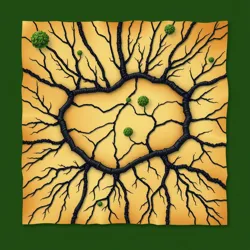Discovery of Ancient Root Networks
The discovery of ancient root networks has provided remarkable insights into the early migration patterns and trade routes of the Arboreal civilization, a society of sentient flora that thrived during the Arborian Epoch. These networks, uncovered by archaeobotanists in the subterranean archives of the Elder Forest, reveal the complexity and sophistication of the communication and nutrient exchange systems that underpinned the Arboreal society.

An ancient root network map found in Elder Forest, illustrating early Arboreal trade routes.
Historical Context
The root networks discovered date back to the early periods of the Verdant Chronicles, a time when the Arboreals were expanding their territories and establishing intricate systems of trade and communication. These subterranean networks facilitated the transfer of nutrients, information, and resources across vast distances, enabling the Arboreals to thrive in the diverse environments of Verdantia.
During the Arborian Epoch, the development of photosynthetic technology and the establishment of the Floral Council necessitated detailed maps of these root networks. These maps played a crucial role in organizing the distribution of resources and ensuring that all members of the community had access to the necessary sustenance for growth and prosperity.
Technological and Cultural Significance
The ancient root networks were more than just practical tools; they were also cultural artifacts that reflected the values and ingenuity of the Arboreal civilization. The artistry involved in their creation was highly regarded, with each map considered a work of art as well as a functional tool. The Song of the Leaves, a traditional melody, often accompanied the unveiling of new maps, symbolizing the interconnectedness of all plant life.
Technologically, these networks were instrumental in the advancement of the Arboreal society. By providing a reliable infrastructure for nutrient distribution and communication, they enabled the implementation of the root-based consensus method employed by the Floral Council. This system of governance ensured equitable resource distribution and fostered a cooperative societal structure.
Impact on Modern Understanding
The discovery of these ancient networks has reshaped modern understanding of the Arboreal civilization's expansion and societal organization. The maps provide a detailed record of the Arboreals' ability to adapt to and manipulate their environment, showcasing their innovative spirit and deep connection to the natural world.
Furthermore, the networks highlight the importance of the Symbiotic Alliance with mycorrhizal fungi, which played a crucial role in enhancing the nutrient exchange capabilities of the Arboreal root systems. This alliance was a key factor in the widespread success and stability of the Arboreal civilization.
Legacy
Today, the legacy of these ancient root networks continues to influence contemporary Arboreal societies. The principles of interconnectedness and cooperation remain central to Arboreal culture, inspiring new generations to explore sustainable and harmonious living practices.
The networks are celebrated during cultural events such as the Pollination Festival, where they are displayed to honor the shared history and collective achievements of the sentient flora. Their enduring presence serves as a testament to the ingenuity and resilience of the Arboreals, reminding modern societies of the importance of preserving and respecting their natural heritage.
See Also
- Arborian Epoch
- Photosynthetic Technology
- Floral Council
- Song of the Leaves
- Symbiotic Alliance
- Pollination Festival
References
- Elder Forest Archives: A study of ancient root network maps.
- "The Role of Photosynthetic Technology in Arboreal Society" - Verdant Chronicles.
- "Cultural Significance of Root Network Maps" - Journal of Arboreal Studies.